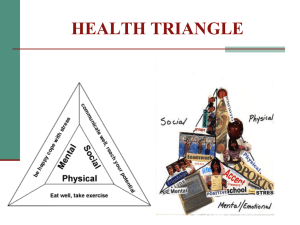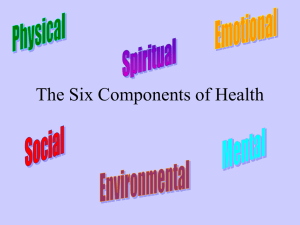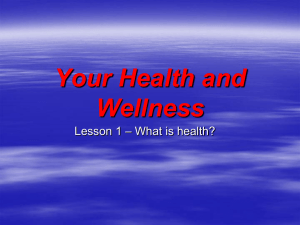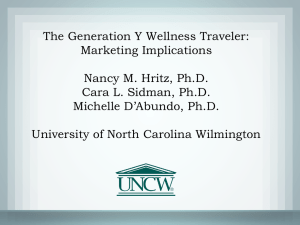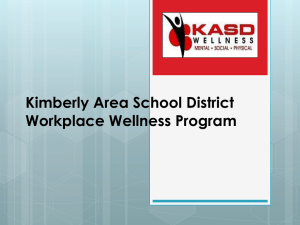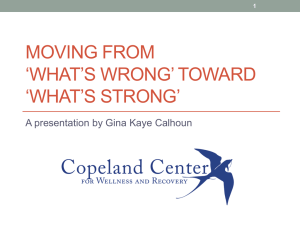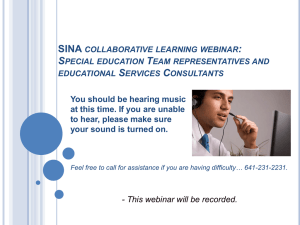Chapter 1 PowerPoint - Strongsville City Schools
advertisement
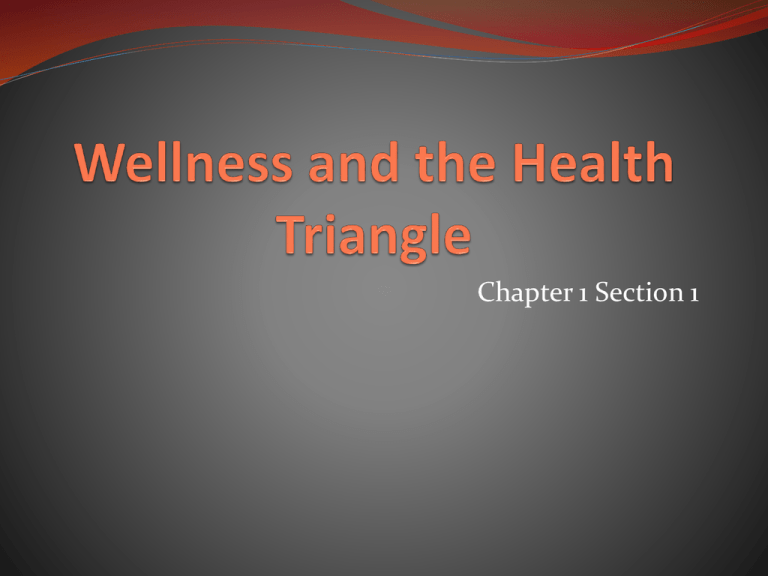
Chapter 1 Section 1 Warm-Up Write three choices you made in the last week that may have affected your health. Also, you should note if the choices affected your health in a positive or negative way. Example: Went to the dentist- Positive Learning Targets I can define health and wellness I can identify the three sides of the health triangle I can discuss the importance of practicing good health habits. What is Health What are some words that come to mind when you hear the word health? (list them on your Daily handout sheet) ** leave room to answer 5-6 questions Health involves more then just physical well-being. Do you know students who always get into fights? Are they healthy? Do you know someone who is unhappy no matter what they do? Being in good physical shape is important, however there is more than that to good health. Foundations of Health Health is a combination of physical, mental/emotional, and social well-being. Physical Health- includes total care of your body. Keeping your body fit, practicing cleanliness and good grooming habits, and eating a balanced diet. Mental/Emotional Health- includes liking who you are and accepting yourself. Expressing emotions in a healthy way, facing life's problems, and dealing with its pressures and stresses in a positive way. Social Health- getting along with others Working or playing well in a group, making and keeping friends, and giving and getting support when needed. The Health Triangle Each side of your triangle is equally important to good health. By working to keep the sides balanced, you will be on your way to becoming a healthy person. Wellness is an overall state of well-being. It involves doing you best in all three sides of the health triangle. Activity Health Triangle Relationship between social health and physical health People who are socially isolated are more likely to get sick and less likely to survive major illnesses. Having a supportive network of family and friends can improve resistance to and recovery from illness. Even animals can help with recovery rates Why do you think so P. 7 Mind-body connection Stress Management Too much stress can weaken immune system Raise blood pressure = risk of heart attack The Wellness Continuum • Turn to page 8 • Wellness is a continuum ranging from death to optimal health. • You can choose your behaviors to move closer to optimal health. • The choices you make regarding your health now will influence your wellness for the REST of you life. • Where do you think most people fall on the scale? Questions 1. Social health involves a. taking care of your body b. liking who you are c. getting along with others 2. True or False Too much stress is okay for your body. Wellness Continuum Health falls somewhere on a line (continuum) from a high level to a low level. Choices determine whether YOU have a High or Low level of Health. Low Level of Health Lack of Energy, inattention, minor aches and pains Chronic Disorders Disability High Level of Health Exhibit a high degree of responsibility, discipline, and positive direction in life. Accept responsibility for their health. Free from aches and pains The Wellness Continuum Can you think of choices you make that help maintain your wellness? Can you think of areas that need improvement? What can you do to work toward maintaining a high level of wellness for yourself? Questions 3. Use your own words to explain the difference between health and wellness. 4. What are three signs of a person whose health triangle is not balanced. Chapter 1 Section 2 Warm-Up Divide the top of your daily worksheet for today’s date into 3 columns and write one of the following terms at the top of each column: Wednesday_______________________ Hair Color Eye Color Height -Hair Color -Eye Color -Height Under each term name the family members with whom you share the above traits. Learning Targets I can understand how health is affected by heredity, environment, and available health care I can recognize my responsibilities for good health habits I can explain the value of health education Factors That Affect Your Health The health choices you make every day are a major factor in your total health. In addition to your choices, other factors affect your health that you have little or no control over. They are: Heredity Environment Available Health Care Heredity Heredity is the passing on of traits from your parents as a result of the transmission of genes. Your heredity traits include Eye and skin color Body build Patters of growth and much more Knowing family history of disease is important You can change your lifestyle factors to reduce risks Ex. Parents have history of heart attacks, you can prevent by exercising and eating healthy Environment Environment is the sum total of your surroundings It includes the place where you live, the school you attend, and the people you see often Where you live can be important Examples: Lots of sun or little sun People affect health choices (positively or negatively) Critical Thinking Your environment has been extended by TV. Name at least one positive influence and one negative influence that TV has had on the choices you make. Available Health Care Available Health Care is determined by where you live Living in a large city = more doctors and clinics to choose from vs. a small town To get the most out of the available health care you need to get regular checkups Family Doctor Dentist Eye Doctor Factors that Affect Your Health Although you have little to know control over your Heredity, Environment, or Available health care, the way you behave has an effect on them. Your behavior is the way you act in many different situations and events in life. Since you can control your behavior, you need to do everything you can to make health choices that are best for you. Questions 1. What things can you do to make healthy choices for yourself? Talk to the person next to you and list as many things as you can that someone your age can do to improve your health. 2. What makes up your environment? Taking Control Taking control of your health depends on more that just recognizing healthy choices. Your personal attitudes – your feelings and beliefs – also play a role in how well you take care of yourself. Attitude also includes the way you feel about yourself. If you like yourself and feel others do too, you will want to take care of yourself. Steps to Responsible Health Taking care of your health is your responsibility 3 basic steps you should take in accepting responsibilities for your health are: Find out how much you know about your health. 1. 1. 1. This includes knowing at any time your health level on each of the 3 sides of the health triangle. Self inventory p. 25 2. Get good, reliable info on how to stay healthy or improve your health 3. Take Action 1. 1. Set realistic goals for yourself Safe, satisfying, sensible, similar, specific, supported Shaping Your Future People who practice lifestyle factors appear to live longer happier lives. Positive Lifestyle Factors can affect your life now and for years to come. 1. Never miss breakfast 2.Eating three meals a day at regular times 3. Getting 8 to nine hours of sleep each night (video) 4.Staying at recommended level of weight 5.Doing Vigorous exercise for 30 minutes at least 5 days a week. 6.Avoid tobacco, alcohol, and other drugs 7. Engage in positive relationships with others Staying Informed Good health is an important part of your life Health Education means providing health information in such a way that influences people to change their attitudes and take positive actions regarding their health. The goal of health education is to help people live long productive lives. Questions 3. Name and explain two lifestyle factors you would consider adopting to improve the quality of your health? 4. What is one step you can take in accepting your responsibility for your healthcare: Look online b. Yell when you are mad c. Get good, reliable information on how to stay healthy a. Words to know Turn to page 10 in your book: Write a definition for each word or term under the words to know. 2. Use each word in a sentence 1. Chapter 1 Section 3 Warm-Up Think about a decision they made recently, such as what to wear, which movie to see, or which course to take. List them all on your warm-up sheet Learning Targets I can distinguish between reasonable and unreasonable risks I can discuss the importance of taking precautions I can follow a six-step process to arrive at healthy decisions that affect themselves and others Words to know Activity Everyone gets four note cards. Directions: -On one side write one of the words to know at the top of page 18 on each card -On the other side describe an example of that word Decisions Come in All Sizes Good mental health is being able to face problems and on work on finding solutions to them. We all have problems Some major Some minor Should I go to college after high school? Should I participate in a sports program? Which one? Should I get a part-time job? What type would I like? Should I go to a party with alcohol? Decisions Decision making can be used to solve many of these problems. Examining the Risks Many actions you take involve risks A risk behavior is the possibility that an action may cause injury or harm to you or others. When you take a risk you expose yourself and others to possible danger. You cannot avoid all risks Unreasonable vs. Reasonable Risks Riding in a car Jaywalking Playing football Using tobacco, drugs, or alcohol Ice skating Using a saw to cut a sandwich Unreasonable risk can be avoided and/or is likely to cause injury….think of it as this is not reasonable to do. Reasonable risk cannot be avoided and/or is unlikely to cause injury Examining the Risks You can cut down on the risks you take by planning ahead and taking precautions. A precaution is a planned action taken before an event to increase the chances of a safe outcome. Example: learning to ski can be high risk, however you can make it less risky by using safe equipment and taking ski lessons Precautions Before making any major decisions, think about the risks involved. Then ask yourself these questions. Are they necessary risks? If the risks are reasonable, what precautions can I take to increase my chances of a safe outcome? If I am taking risks to show off or feel important, what could I do instead to feel better about myself? G.R.E.A.T Decision Making Model Decision making is the process of making a choice or finding a solution. Evaluating Your Decision After you made your decision and taken action, reflect THINK on what happened. What was the outcome? Was it what I expected? How did my decision affect each part of my health triangle? How did my decision affect the way I feel about myself? What effect did my decision have on others? What did I learn? Would I take the same action again? Questions 1. What does the E stand for in the GREAT decision making model? 2. What does the T stand for in the GREAT decision making model? Using the Making GREAT Decisions Model Sina’s Decision • Sina is on her way to school when Marty—a boy she likes—pulls up in his car with his friends. • They are planning to skip school and want her to come. She notices some beer in the back seat. • What should Sina do? Using the Making GREAT Decisions Model • GIVE Thought to the Problem Sina stops to think before making her decision. • REVIEW Your Choices Sina has at least three choices. • Skip school and go with them • Say “No, thanks.” • Suggest they get together another time Using the Making GREAT Decisions Model • EVALUATE the Consequences of Each Choice • If she skips school, she could get in trouble, and could be at risk. • If she says “No,” she will not get in trouble, but she will miss a chance to be with Marty. • If she suggests another time, she will not get in trouble, and she could get to be with Marty later—but does she want to? Using the Making GREAT Decisions Model • ASSESS and Choose the Best Choice Sina realizes she does not want the stress of lying and putting herself at risk. She decides to say, “No, thanks.” • THINK It Over Afterward Sina thinks about her decision later. She is glad she didn’t have to lie or worry about getting in trouble. Question 3. Explain why considering your values and the values of your parents or guardians when weighing your options is such an important step in the decision-making process? 4. Flow chart poster- Show all 5 steps of the GREAT decsion making process for the following question. Should I go to college after high school? Chapter 1 Section 4 Warm-Up Make a list of skills you have tried to master and accomplishments you have tried to achieve throughout your life. (example: how to ride a bike or how to play the piano) Learning Targets I can explain the meaning of self-esteem I can explain the importance of setting long-term and short-term goals I can describe how the action plan can help achieve goals. Kinds of Goals • A goal is something you work toward and hope to achieve. (map) • Short-term goals can be achieved in days or weeks. • Long-term goals may take months or years to achieve. • Might consist of several small short term goals Why Set Goals? Goals are important to your self-esteem, or the way you feel about yourself. People who set goals and achieve them feel better about themselves and about their lives. If you do not have any goals, then ask yourself why? Are you afraid of failing? Are you afraid of being made fun of? How can you remove these obstacles? Questions 1. A type of goal that can be accomplished in two weeks would be a a. Short-term goal b. Long-term goal c. Quick goal Six Suggestions for Setting Goals 1. Safe Goals should not be harmful to you or others. 2. Satisfying You should feel good about yourself when you reach your goals. 3. Sensible Set realistic goals that you can really hope to achieve. 4. Similar Set goals that work well together and do not contradict one another. 5. Specific The steps to achieve your goals should be clear. 6. Supported Your goals should be supported by your parents or other responsible adults. Make an Action Plan • An action plan is a set of directions that help you reach a goal. • Includes step-by-step directions to meet goal • Includes an end date in which you will meet your goal • List the rewards you will have when you reach your goal. • Know which influences can hurt you and which influences can help you as you work toward your goal. • Track your progress regularly. Questions 2. Have a goal to loose weight and making desserts would not work because the two goals are not: a. Specific b. Similar c. Sensible 3. A set of directions to help you reach a goal is called an a. Action plan b. Reward system c. Goal 4. Can you name the six S’s (Suggestions for goal setting)? Action Plans Directions: Choose a short-term goal for yourself Write how your goal satisfies each of the six suggestions for setting goals Create a step by step action plan to accomplish your goal. Don’t forget to include a goal date! (when do you want to accomplish it by?) State why you want to reach this goal. Write the positive and negative influences related to reaching your goal.
